Zotac GeForce GTX 660 with GK106 GPU Review

As the Kepler architecture gets more affordable, we want to take a look at Zotac’s GeForce GTX 660 graphics card.
The recent release of the GeForce GTX 660 Ti graphics card at a recommended price of $299 didn’t really bring the Kepler architecture down into the mainstream sector, but today’s announcement does. The new GeForce GTX 660 and GTX 650 models come at a recommended $229 and $109, respectively, and we’re going to have a close look at Zotac’s version of the former right now. The GeForce GTX 650 will be covered in an upcoming review very soon.
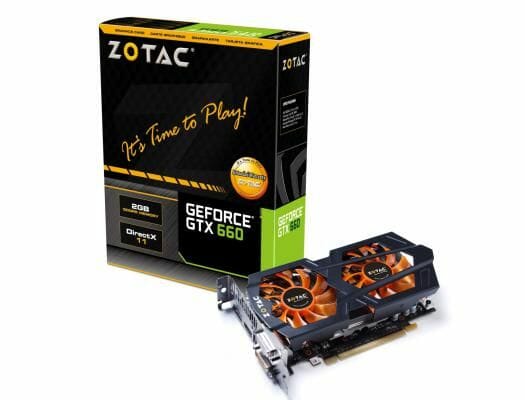
Being one of the first to hit the market, the Zotac GeForce GTX 660 2GB is not a copy of the reference design but an original product with a custom cooler and slightly pre-overclocked frequencies. Moreover, Zotac also offers an accelerated AMP! Edition which, hopefully, will soon make it into our test labs, too. But now we’re talking exclusively about the new GeForce GTX 660.
Closer Look at Zotac GeForce GTX 660 2 GB Graphics Card
GeForce GTX 660: Positioning and Specifications
Putting the $229 price tag on the GeForce GTX 660, Nvidia obviously wants to pit this product against the AMD Radeon HD 7870 GHz Edition which has gone through two price cuts (before and after the GeForce GTX 660 Ti announcement) and now costs $249. More importantly, the new GTX 660 claims to raise the performance bar in the mainstream segment to an unprecedented level. Here are some numbers from Nvidia: the GeForce GTX 460 released in 2010 was 2.5 times as fast as the GeForce 9800 GT whereas the new GeForce GTX 660 is expected to be 4.3 times as fast.
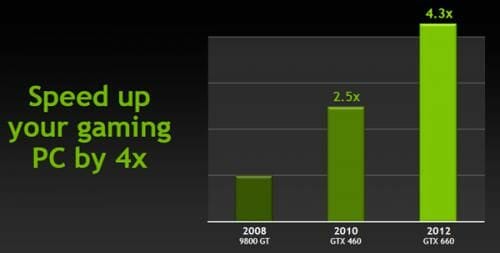
And here’s the difference in frames per second:
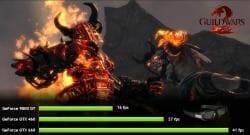
The newest titles Borderlands 2 and Guild Wars 2 are absolutely unplayable on the GeForce 9800 GT, hardly playable on the GeForce GTX 460 and run smoothly enough on the GeForce GTX 660. The new card’s GK106 GPU features five active SMX multiprocessors for a total of 960 CUDA cores (universal shader processors).
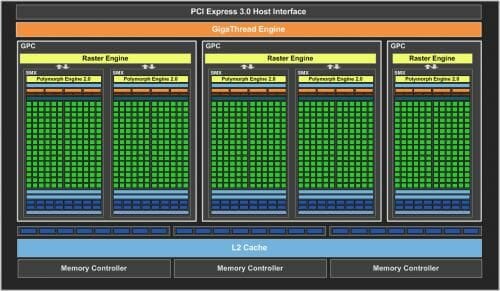
Compare this to the GeForce GTX 660 Ti with its seven SMX multiprocessors and 1344 shader processors.
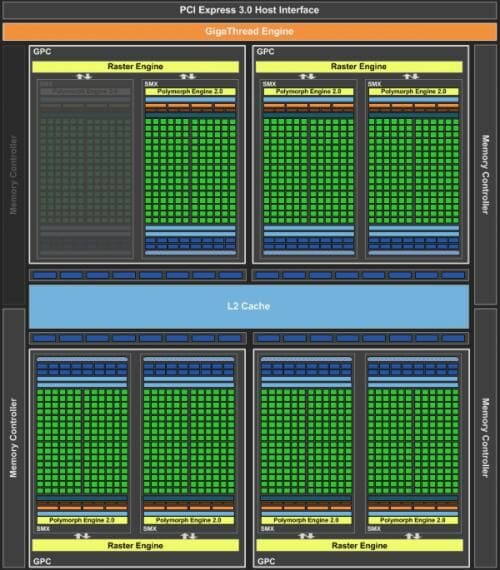
Thus, the GeForce GTX 660 has 80 texture-mapping units while the GTX 660 Ti has 112, but each card has 24 raster operators. The memory bus and frequency have remained the same, too. The following table lists the specs of these cards in comparison with the AMD Radeon HD 7870 GHz Edition, with differences marked in bold:
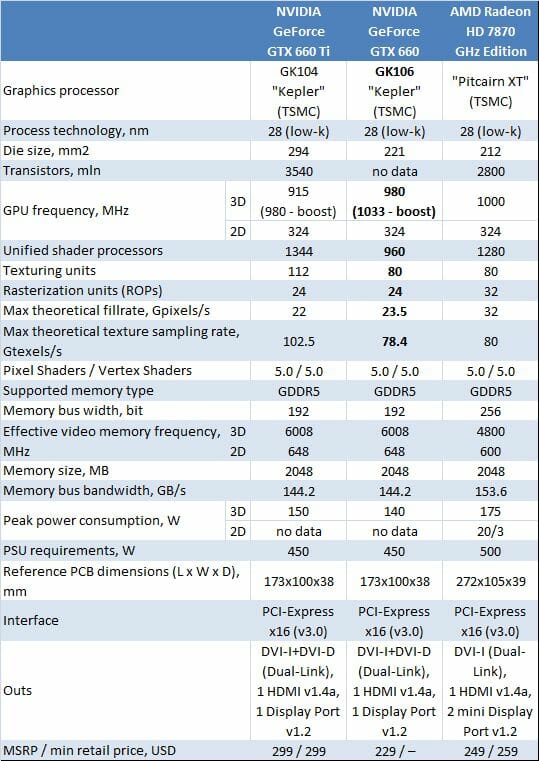
Like the rest of the Kepler GPUs, the new GK106 offers all modern technologies from Nvidia including adaptive V-Sync, NVENC encoder, support for up to four monitors concurrently, GPU Boost, FXAA and TXAA antialiasing.
Packaging and Accessories
The graphics card is shipped in a small cardboard box. The product’s model name, memory amount, DirectX 11 support and extended warranty are all indicated on the front of the packaging:
Similar to the Zotac GeForce GTX 660 Ti, there’s a picture of the card on the back of the box. Two icons tell you that the card’s cooler is 10°C more efficient and 10 dB quieter than the reference one. Key product features, supported Nvidia technologies and minimum system requirements are all listed there, too.
The Zotac GeForce GTX 660 2GB is shipped together with the following accessories: one power adapter, a DVI->D-Sub adapter, a CD with drivers, utilities and other software, short and long versions of the installation guide, and a coupon for downloading TrackMania 2.
The graphics card is manufactured in China and has a recommended price of $229, exactly as the reference GeForce GTX 660 2GB. Zotac provides an extended 3-year warranty for this product.
Design and Features
The Zotac GeForce GTX 660 2GB is as compact as its Ti cousin, measuring 173x100x38 millimeters. It’s actually rather hard to tell them from each other.
The new card is equipped with DVI-I and DVI-D (dual-link) outputs as well as with HDMI and DisplayPort. There’s also a vent grid in the mounting bracket to exhaust the hot air out of the system case.
The GeForce GTX 660 has only one MIO connector (for building SLI configurations) and one 6-pin power connector.
Thus, you can only join two such cards in a SLI setup. The peak power consumption of the GeForce GTX 660 is specified to be 140 watts while its typical 3D consumption is 115 watts. A 450-watt or higher PSU is recommended for a system with this graphics card (the same as for the Ti version).
The GPU is placed in the center of the small PCB. It’s surrounded by memory chips.In the back part of the PCB, below the small aluminum heatsink with thermal pad, there are four phases of the GPU voltage regulator.
One phase is placed between the GPU and the video connectors. It is responsible for the memory chips and has no cooling.The card’s GK106 revision A1 processor was manufactured in Taiwan on the 31st week of 2012 (late July or early August).
It is 24.8% smaller than the GK104, but the exact transistor count is not yet disclosed. The base GPU frequency in 3D mode is 993 MHz (1059 MHz in the boost mode), which is 78 MHz higher than the base frequency of the GeForce GTX 660 Ti. The Zotac is pre-overclocked by a mere 13 MHz compared to the reference GTX 660. The GPU voltage is 1.175 volts. In 2D mode the GPU frequency is dropped to 324 MHz at a voltage of 0.987 volts.
Unlike all of the Kepler-based graphics cards we’ve tested previously (with the exception of a dual-processor GeForce GTX 690), the Zotac GeForce GTX 660 carries memory chips from Samsung rather than Hynix.
Labeled K4G20325FD-FC03, the chips have a voltage of 1.35 volts and a rated clock rate of 6000 MHz. The card indeed clocks them at 6000 MHz. Coupled with the 192-bit bus, the GeForce GTX 660 has a peak memory bandwidth of 144.2 GB/s, like its Ti cousin.
The latest GPU-Z is already aware of the existence of the GeForce GTX 660 and reports its specs correctly.There are still no tools available that could read the BIOS of Nvidia’s GeForce GTX 6xx series cards, so let’s move on to examine the cooler.
Cooling System
The Zotac GeForce GTX 660 features Zotac’s original Dual Silencer in a simplified version with two rather than three heat pipes.
The copper heat pipes are still 6 millimeters in diameter, though. They go out of the copper base and pierce the aluminum heatsink. The pipes are soldered to the base and to the heatsink fins. Above them, there is a decorative metallic casing with two 70mm orange-colored fans.
Labeled FD7010H12S, the fans are manufactured by FirstD.
Their speed is PWM-regulated from 1400 to 3500 RPM. The sleeve bearing is specified to last 40,000 hours while the peak power consumption of each fan is no higher than 4.2 watts.
We checked out the card’s temperature during five consecutive runs of Aliens vs. Predator (2010) with the highest image quality settings at 2560×1440 with 16x anisotropic filtering and MSAA 4x antialiasing. We used MSI Afterburner 2.2.3 and GPU-Z 0.6.4 as our monitoring tools. This test was performed in a closed system case at a room temperature of 20°C. We didn’t replace the card’s default thermal interface.
With the fans regulated automatically, the GPU of the Zotac card was 66°C hot and the fans accelerated from 1400 to 2220 RPM. At the maximum speed of 3500 RPM, the GPU was only 54°C hot, which is very good for such a modest cooler. Of course, the card is noisy in the latter case, but no cooler can be quiet at such a high speed. Well, let’s discuss the noise factor in the next section.
Noise Level
We measured the level of noise using an electronic noise-level meter CENTER-321 in a closed and quiet room about 20 sq. meters large. The noise-level meter was set on a tripod at a distance of 15 centimeters from the graphics card which was installed on an open testbed. The mainboard with the graphics card was placed at an edge of a desk on a foam-rubber tray.
The bottom limit of our noise-level meter is 29.8 dBA whereas the subjectively comfortable (not low, but comfortable) level of noise when measured from that distance is about 36 dBA. The speed of the graphics card’s fans was being adjusted by means of a controller that changed the supply voltage in steps of 0.5 V.
We’ve included the results of the reference Nvidia GeForce GTX 660 and AMD Radeon HD 7870 GHz Edition in the diagram below for the sake of comparison. The vertical dotted lines mark the speed of the fans in the automatic regulation mode. Here are the results.
Zotac’s Dual Silencer is much quieter than the reference coolers from AMD and Nvidia. In fact, it is a really quiet cooler that is absolutely silent in 2D mode and hardly audible in 3D applications. An impressive performance.
Overclocking Potential
We set the Power Limit at the maximum 110% to check out the overclockability of our Zotac GeForce GTX 660.It is impossible to increase the GPU voltage of a GeForce GTX 660 card, so we only managed to raise the GPU clock rate by 90 MHz from its default 993 MHz. The memory chips could be overclocked by 660 MHz.
The resulting GPU and memory clock rates were 1083 and 6668 MHz, respectively.That’s not much of overclocking, considering that Radeon HD 78xx and 78xx cards can reach 1200 MHz in GPU frequency and 7000 MHz in memory frequency, even though the boost frequency of our overclocked GPU was as high as 1175 MHz.
By the way, take note that the card’s temperature didn’t change after overclocking, and the peak speed of the fans remained the same, too. That’s another proof of the highest efficiency of Zotac’s original cooler.
Power Consumption
We measured the power consumption of our testbed equipped with different graphics cards using a multifunctional Zalman ZM-MFC3 panel which can report how much power a computer (without the monitor) draws from a wall outlet. There were two test modes: 2D (editing documents in Microsoft Word or web surfing) and 3D (three runs of the Metro 2033: The Last Refuge benchmark at 2560×1440 with maximum image quality settings).
The system with the new GeForce GTX 660 is obviously the most economical here, requiring less than 400 watts. The Radeon HD 7870 GHz Edition needs 25 to 30 watts more, which is not a big difference. And the GeForce GTX 660 Ti needs 35 watts more than the GTX 660. The systems with different graphics cards need about the same amount of power when idle. Overall, modest power consumption is typical of graphics cards of this class.
Testbed Configuration and Testing Methodology
All participating graphics cards were tested with the following testbed configuration:
- Mainboard: Intel Siler DX79SI (Intel X79 Express, LGA 2011, BIOS 0537 from 23/07/2012);
- CPU: Intel Core i7-3960X Extreme Edition, 3.3 GHz, 1.2 V, 6 x 256 KB L2, 15 MB L3 (Sandy Bridge-E, C1, 32 nm);
- CPU cooler: Phanteks PH-TC14PE (2 x 135 mm fans at 900 RPM);
- Thermal interface: ARCTIC MX-4;
- System memory: DDR3 4 x 4GB Mushkin Redline (2133 MHz / 9-10-10-28 / 1.65 V);
- Graphics cards:
- EVGA GeForce GTX 660 Ti Super Clocked 2GB (256-bit GDDR5, 915/980/6008 MHz);
- Zotac GeForce GTX 660 2GB (192-bit GDDR5, 993/1059/6008 MHz, 1083/1149/6668 MHz);
- Sapphire Radeon HD 7870 OC Dual-X 2GB (256-bit GDDR5, 1000/4800 MHz and 1240/6080 MHz);
- System drive: Crucial m4 256 GB SSD (SATA-III,CT256M4SSD2, BIOS v0009);
- Drive for programs and games: Western Digital VelociRaptor (300GB, SATA-II, 10000 RPM, 16MB cache, NCQ) inside a Scythe Quiet Drive 3.5” HDD silencer and cooler;
- Backup drive: Samsung Ecogreen F4 HD204UI (SATA-II, 2 TB, 5400 RPM, 32 MB, NCQ);
- System case: Antec Twelve Hundred (front panel: three Noiseblocker NB-Multiframe S-Series MF12-S2 fans at 1020 RPM; back panel: two Noiseblocker NB-BlackSilentPRO PL-1 fans at 1020 RPM; top panel: default 200 mm fan at 400 RPM);
- Control and monitoring panel: Zalman ZM-MFC3;
- Power supply: Seasonic SS-1000XP Active PFC F3 (1000 watts, 120 mm fan);
- Monitor: 27” Samsung S27A850D (DVI-I, 2560×1440, 60 Hz).
The first competitor to the new Zotac GeForce 660 is the EVGA GeForce GTX 660 Ti Super Clocked whose clock rates are set to match those of the reference GTX 660 Ti.
Thus, we’ll be able to see the difference between the two GTX 66x series cards.AMD is represented by the Sapphire Radeon HD 7870 OC Dual-X 2GB whose clock rates are set to match those of the reference Radeon HD 7870 GHz Edition.
So, the two market opponents will clash face to face. The Sapphire is additionally benchmarked at 1240/6080 MHz.In order to lower the dependence of the graphics cards performance on the overall platform speed, we overclocked our 32 nm six-core CPU with the multiplier set at 37x, BCLK frequency set at 125 MHz and “Load-Line Calibration” enabled to 4.625 GHz. The processor Vcore was increased to 1.49 V in the mainboard’s BIOS.
Hyper-Threading technology was enabled. 16 GB of system DDR3 memory worked at 2 GHz frequency with 9-11-10-28 timings and 1.65V voltage.The test session started on September 8, 2012. All tests were performed in Microsoft Windows 7 Ultimate x64 SP1 with all critical updates as of that date and the following drivers:
- Intel Chipset Drivers 9.3.0.1020 WHQL from 27/07/2012 for the mainboard chipset;
- DirectX End-User Runtimes from November 30, 2010;
- AMD Catalyst 12.8 (8.982.0.0) driver from 15/08/2012 + Catalyst Application Profiles 12.8 (CAP2);
- Nvidia GeForce 306.23 beta driver from 27/08/2012 for Nvidia based graphics cards.
We ran our tests in the following two resolutions: 1920×1080 and 2560×1440 pixels. The tests were performed in two image quality modes: “Quality+AF16x” – default texturing quality in the drivers with enabled 16x anisotropic filtering and “Quality+ AF16x+MSAA 4(8)x” with enabled 16x anisotropic filtering and full screen 4x or 8x antialiasing if the average frame rate was high enough for comfortable gaming experience. We enabled anisotropic filtering and full-screen anti-aliasing from the game settings. If the corresponding options were missing, we changed these settings in the Control Panels of Catalyst and GeForce drivers. We also disabled Vsync there. There were no other changes in the driver settings.
The list of games and applications used in this test session includes two popular semi-synthetic benchmarking suites, one technical demo and 15 games of various genres with all updates installed as of the beginning of the test session date:
- 3DMark Vantage (DirectX 10) – version 1.0.2.1, Performance and Extreme profiles (only basic tests);
- 3DMark 2011 (DirectX 11) – version 1.0.3.0, Performance and Extreme profiles;
- Unigine Heaven Demo (DirectX 11) – version 3.0, maximum graphics quality settings, tessellation at “extreme”, AF16x, 1280×1024 resolution with MSAA and 1920×1080 with MSAA 8x;
- S.T.A.L.K.E.R.: Call of Pripyat (DirectX 11) – version 1.6.02, Enhanced Dynamic DX11 Lighting profile with all parameters manually set at their maximums, we used our custom cop03 demo on the Backwater map;
- Metro 2033: The Last Refuge (DirectX 10/11) – version 1.2, official benchmark, “Very High” image quality settings; tessellation, DOF enabled, AAA antialiasing enabled, two consecutive runs of the “Frontline” scene;
- Just Cause 2 (DirectX 11) – version 1.0.0.2, maximum quality settings, Background Blur and GPU Water Simulation disabled, two consecutive runs of the “Dark Tower” demo;
- Aliens vs. Predator (2010) (DirectX 11) – Texture Quality “Very High”, Shadow Quality “High”, SSAO enabled, two test runs in each resolution;
- Lost Planet 2 (DirectX 11) – version 1.0, maximum graphics quality settings, motion blur enabled, performance test “B”;
- Sid Meier’s Civilization V (DirectX 11) – version 1.0.1.348, maximum graphics quality settings, two runs of the “diplomatic” benchmark including five heaviest scenes;
- Total War: Shogun 2 (DirectX 11) – version 2.0, built-in benchmark (Sekigahara battle) at maximum graphics quality settings (and 4x MSAA in one mode);
- Crysis 2 (DirectX 11) – version 1.9, we used Adrenaline Crysis 2 Benchmark Tool v.1.0.1.14 BETA with “Ultra High” graphics quality profile and activated HD textures, two runs of a demo recorded on “Times Square” level;
- Hard Reset Demo (DirectX 9) – benchmark built into the demo version with Ultra image quality settings, one test run;
- Batman: Arkham City (DirectX 11) – version 1.2, maximum graphics quality settings, physics disabled, two sequential runs of the benchmark built into the game.
- Battlefield 3 (DirectX 11) – version 1.4, all image quality settings set to “Ultra”, two successive runs of a scripted scene from the beginning of the “Going Hunting” mission 110 seconds long;
- Nexuiz (DirectX 11) – version 1.0, Ultra settings, a double run of the in-built benchmark with High and Ultra profiles.
- DiRT Showdown (DirectX 11) – version 1.0, built-in benchmark at maximum graphics quality settings (“Ultra” preset) on the “Nevada” track.
- Sniper Elite V2 Benchmark (DirectX 11) – version 1.05, we used Adrenaline Sniper Elite V2 Benchmark Tool v1.0.0.2 BETA with maximum graphics quality settings (“Ultra” profile), Advanced Shadows: HIGH, Ambient Occlusion: ON, Stereo 3D: OFF, two sequential test runs.
- Sleeping Dogs (DirectX 11) – version 1.0, built-in benchmark, maximum graphics quality settings, Hi-Res Textures Pack installed, FPS Limiter and V-Sync disabled, a double run of the benchmark with antialiasing at the Normal and Extreme levels.
If the game allowed recording the minimal fps readings, they were also added to the charts. We ran each game test or benchmark twice and took the best result for the diagrams, but only if the difference between them didn’t exceed 1%. If it did exceed 1%, we ran the tests at least one more time to achieve repeatability of results.
Performance Tests
The graphics cards are listed in the diagrams in the order of descending retail price. The results of the Zotac GeForce GTX 660 2GB are in green. Red is the color of the Sapphire Radeon HD 7870 2GB. Blue is for the EVGA GeForce GTX 660 Ti Super Clocked 2GB. Let’s get started!
3DMark VantageThe new GeForce GTX 660 is ahead of its main rival Radeon HD 7870 GHz Edition in the first synthetic benchmark, but falls behind it when both are overclocked. Notwithstanding its higher GPU clock rate, the GTX 660 is slower than the GeForce GTX 660 Ti by 14 to 15%.
3DMark 2011
The newer version of 3DMark shows us the same standings
Unigine Heaven Demo
The GeForce GTX 660 is ahead of the Radeon HD 7870 GHz Edition when we don’t use antialiasing. But when we enable 8x MSAA, the AMD-based card goes ahead. The gap isn’t large, though. The new GeForce GTX 660 is 10 to 20% behind its Ti cousin but can overtake the latter when overclocked.
S.T.A.L.K.E.R.: Call of Pripyat
The Radeon HD 7870 GHz Edition looks preferable in the first game on our list. The GeForce GTX 660 lags behind in each test mode and is also up to 26% slower than the GeForce GTX 660 Ti. Overclocking can’t help bridge the gap, either.
Metro 2033: The Last Refuge
Mainstream graphics cards are generally very slow in Metro 2033: The Last Refuge, yet we can note that the Radeon HD 7870 GHz Edition is faster than the others. This is one of the two games where the difference between the GeForce GTX 660 and GTX 660 Ti is no larger than 5%.
Just Cause 2
The GeForce GTX 660 is ahead of the Radeon HD 7870 GHz Edition when antialiasing is on, but falls behind when antialiasing is off. It is also 13 to 25% behind the GeForce GTX 660 Ti but the gap shrinks to 4 to 19% when the new card is overclocked.
Aliens vs. Predator (2010)
The GeForce GTX 660 is comparable to the Radeon HD 7870 GHz Edition in Aliens vs. Predator (2010) but the latter has higher overclocking potential and goes ahead when both cards are overclocked. It’s 4 to 16% slower compared to the GeForce GTX 660 Ti.
Lost Planet 2
The GeForce series is superior in Lost Planet 2, the more expensive GeForce GTX 660 Ti beating the GTX 660 by 18 to 20%. When overclocked to 1083/6668 MHz, the latter can get as close as 8-13%.
Sid Meier’s Civilization V
Unlike the previous game, Sid Meier’s Civilization V runs faster on the Radeon HD 7870 GHz Edition which even beats the GeForce GTX 660 Ti. Its advantage is especially large when antialiasing is enabled.
Total War: Shogun 2
We see a completely different picture in this game.
The GeForce GTX 660 Ti is no faster than its Radeon opponent without antialiasing but as soon as we enable that feature, it goes ahead.
Crysis 2
The Radeon HD 7870 GHz Edition and the GeForce GTX 660 deliver the same performance in Crysis 2. They aren’t much different from the GeForce GTX 660 Ti, either.
Hard Reset Demo
Here’s one more game where it’s impossible to differentiate between the graphics cards priced at $229-249 as they all have the same performance.
Batman: Arkham City
Antialiasing is important again. When it is turned off, the GeForce GTX 660 is ahead of the Radeon HD 7870 GHz Edition. When it is enabled, the Radeon enjoys a small advantage over its opponent.
Battlefield 3
The GeForce GTX 660 doesn’t differ from the Radeon HD 7870 GHz Edition in Battlefield 3, either.
Nexuiz
Running on CryEngine 3, Nexuiz doesn’t show us a clear winner, although the Radeon HD 7870 GHz Edition is preferable to the GeForce GTX 660.
DiRT Showdown
Radeons have always been superior in this game, so the Radeon HD 7870 GHz Edition enjoys the largest advantage over the GeForce GTX 660 in this test session. The GTX 660 is 10 to 21% behind its Ti cousin. When overclocked, it narrows the gap to 2 to 9%.
Sniper Elite V2 Benchmark
The Radeon HD 7870 GHz Edition scores another win, even though its advantage over the GeForce GTX 660 is smaller than in the previous game.
Sleeping Dogs
We used a new benchmark in this game with the following settings.The results are not in favor of the new GeForce GTX 660.
Performance Summary
First of all, let’s check out the difference between the GeForce GTX 660 (priced at $229) and the GeForce GTX 660 Ti ($299 or 30.6% more expensive), the latter serving as a baseline.The GeForce GTX 660 is 13 to 16% slower than its Ti cousin at 1920×1080 and 13 to 17% slower at 2560×1440 across all the tests. The difference in speed doesn’t seem large considering the 30% difference in price.
Meanwhile, overclocking the GeForce GTX 660 to 1083/6668 MHz doesn’t always help to reach the performance level of the GeForce GTX 660 Ti as is indicated by the next pair of summary diagrams.
With just a couple of exceptions, the GeForce GTX 660 Ti is still in the lead. Other factors being the same, the lack of 28.6% shader processors in the GPU affects the performance of the GeForce GTX 660 so much that the higher clock rates can’t make up for that.Now the key diagram of this test session is GeForce GTX 660 2GB vs. Radeon HD 7870 GHz Edition 2GB at their default clock rates. The AMD-based card being older, it serves as a baseline.
Thus, the new GeForce GTX 660 is ahead in both versions of 3DMark, in Lost Planet 2, in the antialiasing mode of Just Cause 2 and in the MSAA-less mode of Batman: Arkham City. The two cards are equals in such games as Crysis 2, Hard Reset, Battlefield 3 and (at certain settings) in Aliens vs. Predator (2010) and Sid Meier’s Civilization V. The Radeon HD 7870 GHz Edition, in its turn, is superior in the high-quality mode of Unigine Heaven and in a lot of games: S.T.A.L.K.E.R.: Call of Pripyat, Metro 2033: The Last Refuge, Nexuiz, DiRT Showdown, Sniper Elite V2 and Sleeping Dogs. Its advantage is so huge in the last three games that it is an average 3-8% ahead of the GeForce GTX 660 at 1920×1080 and 7 to 9% ahead at 2560×1400 across all the tests.
Conclusion
You’ve just seen the debut of the new Kepler-based GK106 GPU and the corresponding graphics card GeForce GTX 660 2GB priced at a recommended $229. It didn’t surprise us in the slightest, though. It is expectedly slower than the GeForce GTX 660 Ti ($299) and almost equal to the AMD Radeon HD 7870 GHz Edition which has declined in price from $349 to $249. So, Nvidia is again trying to catch up with its rival and is doing that quite successfully, making AMD lower its prices. The overclocking potential of the Radeon HD 7870 GHz Edition is higher but it wouldn’t be quite correct to make any conclusions based on only one sample of GeForce GTX 660. So, like with the GeForce GTX 660 Ti, the market success of the new card is going to be determined by its actual retail price. For example, the GTX 660 Ti received a lot of negative reviews due to its too high recommended price, but it came to sell cheaper than recommended. Let’s see if the GeForce GTX 660 will do the same.
Traditionally for the brand, the Zotac GeForce GTX 660 2GB is a high-quality product. It is compact and economical in terms of power draw, features an efficient and quiet cooler, and supports all modern technologies from Nvidia, including multi-monitor configurations. The overclocking potential of our sample was rather average. We’ll see what other brands have to offer soon, but Zotac’s version of GeForce GTX 660 seems to be an attractive buy in its price range.